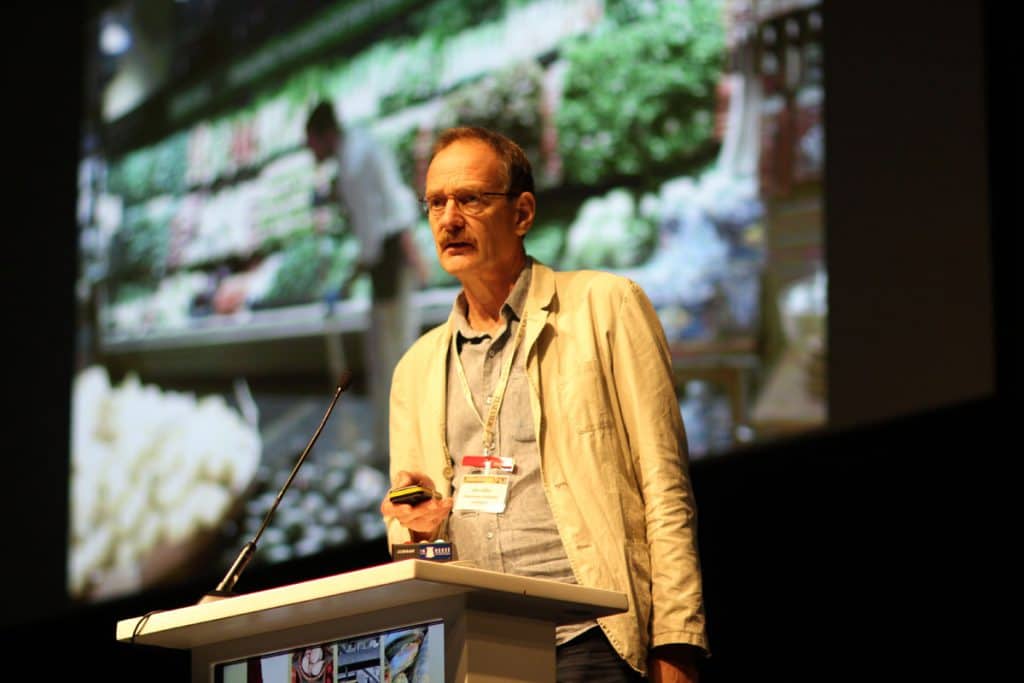The UN’s 2017 State of Food Security and Nutrition in the World report has, for the first time, recorded an uptick in food insecurity in the world. This has triggered conflict in more than 40 countries.

Professor Ken Giller didn’t quite answer the question he posed in the title of his presentation – The future of farming: Who will produce our food? – but he did make it clear that any answer is complex.
Giller, of the Wageningen Centre for Agroecology and Systems Analysis in The Netherlands, was speaking on the second day of the 3rd International Conference on Global Food Security, on at the Cape Town International Conference Centre from 3-6 December 2017. His keynote talk was intended, he said, was to shift focus on farmers, often overlooked in the debate on food security.
Food security, Giller pointed out, was experiencing several pressure points. The UN’s 2017 State of Food Security and Nutrition in the World report has, for the first time, recorded an uptick in food insecurity in the world. This has triggered conflict in more than 40 countries. In addition, predictions are that the global population will increase by one billion people by 2030, the same year in which the Sustainable Development Goals are supposed to be met.
“With that increase in population, with an increase in affluence, then we also see an increase in food demand per capita,” Giller said. There is uncertainty, however, in the predictions of how much food will be demanded by 2030.
In Africa, population growth – be it urban or rural – is expected to exceed that of any other region. This poses a range of challenges for agriculture on the continent. If the biggest concern for farmers on large Australian farms are finding brides, Giller noted, in Africa issues are perhaps more pressing. Here, for instance, most farmers are achieving only 10-20% of potential crop yields, compared to around 90% on average in Europe.
In particular, there are questions around sustainable farm size. A study in Tanzania has shown, for instance, that only around 35-40% of farmers in that country live above the poverty line (around US$1 per day); but most of these, however, fall far short of a proposed ‘living income’ line of around US$7 (to afford farmers a “decent” standard of living). Even if yields were improved to around 50%, only 40% of farmers would be lifted beyond the poverty line at current farm sizes of 0.4 hectares. At current yields, that would mean that farm sizes would have to be increased to around 3.5ha to lift farmers beyond the poverty line, and to 15ha to get them to a living income line.
One conspicuous trend is that farmers rely on off-farm income, such as remittances from those who have moved to urban areas. Others, like farmers in Ethiopia, are moving to profitable cash crops, such as for the drug chat. Then there’s the emergence of ‘investment farmers’ – typically urban households who own large tracts of arable land, creating a form of “elite capture” that pushes up prices of land.
If there is a country in which agriculture has managed to achieve self-sufficiency, it is The Netherlands, explained Giller of his adopted country. But the Dutch have done so on the back of the right policies that support and encourage modernisation, the consolidation of fragmented land, and with tariffs and price support in place, among other advantages. A large part of the credit should go towards generous subsidies in the European Union; in fact, it is estimated that the EU spends some €50 billion a year on subsides, pointed out Giller. In contrast, subsidies in Africa are scarce, and certainly not on the scale that can turn things around for most farmers.
“But it paints a pretty bleak picture of farming around the world,” said Giller. “Farming is not a lucrative profession almost anywhere.”
If there is a take-home message, Giller said, it’s of the link between the rural and urban development. “You can’t imagine that rural development can be independent of urbanisation and urban employment. We need those to go hand in hand to be able to develop agriculture.”
Follow the conversation live on Twitter: @FoodSecurity_za #FOODSEC2017 | #gfs_conf2017 | #GFS2017
related Articles
New book: “Resilience and Food Security in a Food Systems Context”
Resilience and Food Security in a Food Systems Context is a recently published, open-access resource which delves into why we…
Some plants can short-circuit the toxic effects of metals – now scientists...
Some plants can short-circuit the toxic effects of metals – now scientists are trying to harness their power Heavy metals can…
Breede River Municipality hosts unique food security learning journey
“During two sunny winter days in early May, the Breede River Municipality (BVM) hosted a ‘learning journey’, an innovative…



